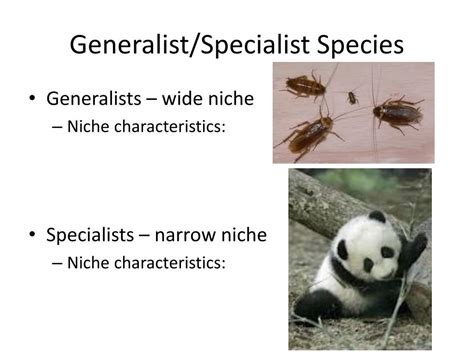Introduction
In the vibrant tapestry of life, generalist species stand out for their remarkable ability to thrive in a wide range of habitats and exploit diverse food sources. These versatile creatures are ecological all-rounders, capable of adapting to changing environments and maintaining healthy populations. This article delves into the fascinating world of generalist species, exploring their characteristics, ecological roles, and implications for conservation.

Characteristics of Generalist Species
Generalist species possess several key characteristics that enable them to thrive in various settings:
- Broad Dietary Range: Generalists exhibit a wide acceptance of food sources, allowing them to capitalize on different prey or plant species.
- Flexible Behavior: They display behavioral plasticity, adapting their behaviors to different environmental conditions and food availability.
- High Resilience: Generalists are often resilient to environmental disturbances and can recover quickly from population declines.
- Low Trophic Position: Many generalists occupy low trophic levels in food webs, indicating their ability to feed on a variety of organisms and avoid competition with specialized predators.
Types of Generalist Species
The list of generalist species is vast, ranging from microorganisms to large mammals. Some notable examples include:
Animals:
- Coyotes
- Raccoons
- Songbirds
- Insects
- Rodents
Plants:
- Grasses
- Dandelions
- Trees
Microorganisms:
- Bacteria
- Fungi
Ecological Roles of Generalists
Generalist species play crucial roles in ecosystems:
- Ecosystem Stability: They buffer ecosystems from disturbances by maintaining populations in varying conditions.
- Food Web Dynamics: Generalists connect different trophic levels, facilitating energy flow and preventing population explosions.
- Seed Dispersal: Many generalists disperse seeds of various plant species, aiding in reforestation and genetic diversity.
- Nutrient Cycling: Generalists can process organic matter and recycle nutrients back into the ecosystem.
Conservation Implications
Generalist species are often overlooked in conservation efforts, yet they are essential components of healthy ecosystems. Their ability to adapt and thrive in different habitats makes them valuable indicators of environmental change:
- Sentinel Species: Generalists can serve as early warning systems for ecosystem degradation or pollution.
- Umbrella Species: Their broad distribution can protect other species that share their habitat.
- Ecosystem Services: Generalists provide ecosystem services such as pest control and pollination, which benefit human society.
Common Mistakes to Avoid
- Ignoring Generalists: Underestimating the importance of generalist species can lead to ecological imbalances and ecosystem vulnerability.
- Focusing Solely on Specialists: Conservation strategies that prioritize specialized species alone may neglect the essential roles of generalists.
- Homogenization: Over-reliance on generalist species can homogenize ecosystems and reduce biodiversity.
How to Step-by-Step Approach
To enhance the ecological health of ecosystems, consider these steps:
- Identify and Monitor: Conduct surveys and monitoring programs to assess generalist species populations and their ecological roles.
- Protect Habitats: Protect habitats that support diverse generalist species, ensuring their access to food, shelter, and breeding sites.
- Promote Resilience: Implement management practices that enhance ecosystem resilience, such as restoring natural processes and reducing pollution.
- Encourage Native Species: Support native generalist species by promoting their establishment and expansion.
Frequently Asked Questions (FAQs)
-
What is the difference between generalists and specialists?
Generalists have a broad dietary range and flexible behaviors, while specialists are adapted to a narrow range of food sources and habitats. -
Can invasive species be generalists?
Yes, invasive species can often be generalists, enabling them to thrive in new environments and outcompete native species. -
How do humans impact generalist species?
Human activities such as habitat degradation, pollution, and climate change can negatively affect generalist species populations. -
What is the importance of generalist species for human society?
Generalist species provide ecosystem services such as pollination, pest control, and seed dispersal, which benefit human agriculture and well-being. -
Can generalists be used as indicators of ecosystem health?
Yes, changes in generalist species populations can indicate altered environmental conditions or ecosystem degradation. -
How can we support generalist species conservation?
Protecting their habitats, reducing pollution, and promoting ecological restoration are key strategies for supporting generalist species conservation.
Conclusion
Generalist species are ecological powerhouses that underpin the stability and resilience of ecosystems. Their ability to adapt and thrive in diverse environments highlights their importance for biodiversity conservation and human well-being. By recognizing and valuing the ecological roles of generalists, we can safeguard healthy ecosystems and ensure a sustainable future for both wildlife and humanity.
Tables
Table 1: Examples of Generalist Species
| Category | Species |
|---|---|
| Animals | Coyotes, Raccoons, Songbirds |
| Plants | Grasses, Dandelions, Trees |
| Microorganisms | Bacteria, Fungi |
Table 2: Ecological Roles of Generalists
| Role | Function |
|---|---|
| Ecosystem Stability | Buffering ecosystems from disturbances |
| Food Web Dynamics | Connecting different trophic levels |
| Seed Dispersal | Aiding in plant reforestation and genetic diversity |
| Nutrient Cycling | Recycling nutrients back into the ecosystem |
Table 3: Common Mistakes to Avoid in Generalist Species Conservation
| Mistake | Impact |
|---|---|
| Ignoring Generalists | Underestimating their importance and ecological imbalances |
| Focusing Solely on Specialists | Neglecting the essential roles of generalists |
| Homogenization | Reducing biodiversity and ecosystem resilience |
Table 4: Step-by-Step Approach to Enhance Generalist Species Conservation
| Step | Action |
|---|---|
| 1 | Identify and Monitor |
| 2 | Protect Habitats |
| 3 | Promote Resilience |
| 4 | Encourage Native Species |
